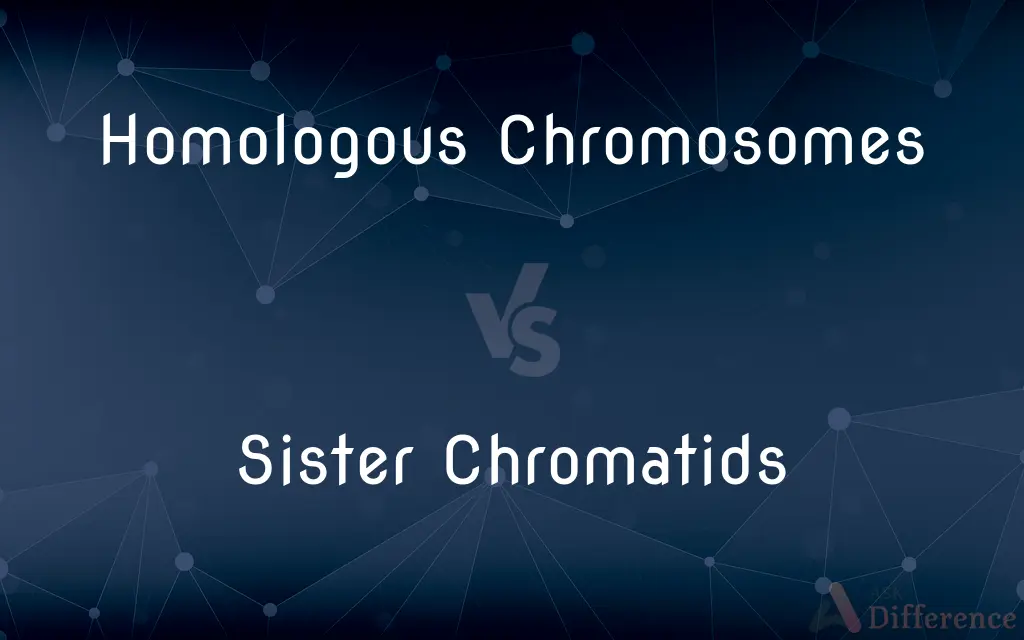Homologous Chromosomes vs. Sister Chromatids — What's the Difference?
By Tayyaba Rehman — Published on October 30, 2023
Homologous Chromosomes are pairs of similar but not identical chromosomes; Sister Chromatids are identical halves of a duplicated chromosome. Both are crucial for genetics.

Difference Between Homologous Chromosomes and Sister Chromatids
Table of Contents
ADVERTISEMENT
Key Differences
Homologous Chromosomes represent two structurally similar chromosomes, one from each parent, that carry genes for the same traits at the same loci, though they can have different alleles. In contrast, Sister Chromatids are the exact replicas of a single chromosome, formed after DNA replication, and are connected by a centromere.
Considering their origin, Homologous Chromosomes are inherited independently from the mother and the father. Each homolog carries genetic information that can differ between parents. Conversely, Sister Chromatids originate from a single chromosome and are therefore identical in sequence.
During meiosis, a type of cell division for reproduction, Homologous Chromosomes pair up and can exchange genetic material in a process called recombination or crossing over. Sister Chromatids, on the other hand, do not undergo crossing over with each other, as they are already identical.
Focusing on segregation, during the first division of meiosis, Homologous Chromosomes are separated, ensuring genetic variability in gametes. During the second division, and also in mitosis, it's the Sister Chromatids that are separated, ensuring each new cell gets an identical set of chromosomes.
Ultimately, while Homologous Chromosomes are essential for understanding genetic inheritance and variability, Sister Chromatids provide insights into DNA replication and precise genetic transmission during cell division.
ADVERTISEMENT
Comparison Chart
Origin
One from each parent
From DNA replication of a single chromosome
Genetic Information
Similar but can have different alleles
Identical
Function in Meiosis
Pair up and can undergo recombination
Separated in the second division
Centromere Connection
No direct connection
Connected by a centromere
Role in Inheritance
Involved in genetic inheritance and variability
Ensure each new cell gets identical set of chromosomes
Compare with Definitions
Homologous Chromosomes
Pairs of chromosomes with similar structure.
Each individual has a set of Homologous Chromosomes, one from each parent.
Sister Chromatids
Identical halves of a duplicated chromosome.
After DNA replication, a chromosome consists of two Sister Chromatids.
Homologous Chromosomes
Separate during the first meiotic division.
The separation of Homologous Chromosomes ensures gametes have a unique genetic composition.
Sister Chromatids
Result from DNA replication.
Before a cell divides, it replicates its DNA, forming Sister Chromatids.
Homologous Chromosomes
Involved in genetic recombination.
During meiosis, Homologous Chromosomes can exchange segments, creating genetic diversity.
Sister Chromatids
Separate during mitosis and meiosis II.
The separation ensures that each daughter cell gets an exact copy of the genetic material.
Homologous Chromosomes
Carry genes for the same traits.
Both chromosomes in a Homologous pair have a gene for eye color, though alleles might differ.
Sister Chromatids
Connected by a centromere.
The centromere holds the Sister Chromatids together until cell division occurs.
Homologous Chromosomes
Define genetic inheritance patterns.
Mendelian genetics often focuses on how alleles on Homologous Chromosomes are inherited.
Sister Chromatids
Are genetically identical.
Any genetic change in one of the Sister Chromatids will be mirrored in the other.
Common Curiosities
What are Homologous Chromosomes?
Homologous Chromosomes are pairs of similar chromosomes, one from each parent, carrying genes for the same traits.
How do Sister Chromatids arise?
Sister Chromatids are formed when a chromosome duplicates its DNA during replication.
Can Homologous Chromosomes be identical?
No, Homologous Chromosomes can carry different alleles, making them similar but not identical.
How do Homologous Chromosomes differ in males and females?
In humans, females have two X Homologous Chromosomes, while males have one X and one Y.
What connects the Sister Chromatids?
The centromere connects the two Sister Chromatids.
Can Sister Chromatids mutate independently?
After replication, any mutation occurring in one chromatid doesn't affect the other.
How many Homologous Chromosomes do humans have?
Humans have 23 pairs of Homologous Chromosomes, totaling 46.
When do Sister Chromatids separate?
Sister Chromatids separate during mitosis and the second division of meiosis.
Why are Homologous Chromosomes important in meiosis?
They pair up and can exchange genetic material, contributing to genetic diversity in offspring.
Do Homologous Chromosomes always have the same genes?
Yes, they have genes at the same loci, but alleles of these genes can differ.
What ensures that Sister Chromatids are identical?
They result from the replication of a single chromosome's DNA.
Are Sister Chromatids ever separated before cell division?
No, they remain connected at the centromere until cell division occurs.
How do organisms inherit Homologous Chromosomes?
They inherit one chromosome of each Homologous pair from each parent.
Do Sister Chromatids play a role in genetic inheritance?
Indirectly; their accurate separation ensures genetic stability across cell divisions.
When can Homologous Chromosomes exchange genetic material?
During meiosis, in a process called crossing over or recombination.
Share Your Discovery

Previous Comparison
Intensive Farming vs. Extensive Farming
Next Comparison
Market Segmentation vs. Target MarketingAuthor Spotlight
Written by
Tayyaba RehmanTayyaba Rehman is a distinguished writer, currently serving as a primary contributor to askdifference.com. As a researcher in semantics and etymology, Tayyaba's passion for the complexity of languages and their distinctions has found a perfect home on the platform. Tayyaba delves into the intricacies of language, distinguishing between commonly confused words and phrases, thereby providing clarity for readers worldwide.













































